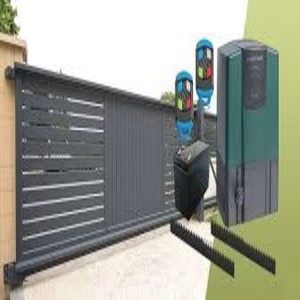Access control
Gate Automation Solution
Gate Automation Solution
What comes to your mind when you hear the term ‘Gate Automation’? Gate automation solution is a systems put in place to seamlessly open and close your gate without necessarily touching or being near it thus, increasing the convenience of using it.
Basically, it involves the use of motorized systems and control technologies to operate gates without manual effort. These systems can be integrated with various access control mechanisms, allowing for secure and efficient entry and exit.
Applications ranges from residential homes, commercial and industrial settings
Types of Automatable Gates;
- Swing Gates
- Single Swing Gate: A single gate panel that swings open in one direction, either inward or outward.
- Double Swing Gate: Two gate panels that swing open from the centre, requiring more space but providing a wider entry.
- Sliding Gates
- Track Sliding Gate: A gate that slides horizontally along a track installed on the ground. Ideal for properties with limited space.
- Cantilever Sliding Gate: A gate that slides without a ground track, suspended above the ground. Suitable for uneven surfaces or areas prone to debris.
- Telescopic Sliding Gate: A gate that consist of two or three sliding gate leaves that close into a space approximately half or one-third the size of the total opening, using a series of pulleys and cables. Telescopic gates are normally automated, and utilise motors that provide increased torque during the initial shunt.
- Bi-Folding Gates
- Gates that fold in the middle as they open, providing a quick opening and closing mechanism. Often used where space is limited.
- Vertical Lift Gates
- Gates that lift vertically to allow access, commonly used in industrial settings where space is a premium.
Key Components of Gate Automation Systems
- Gate Motors: The motor powers the opening and closing of the gate. Types include:
- Electromechanical Motors: Suitable for residential use with moderate traffic.
- Hydraulic Motors: Used in commercial or industrial settings due to their durability and ability to handle heavy gates.
- Control Panels: The brain of the system, managing gate operations, safety features, and user inputs.
- Remote Controls: Handheld devices that allow users to operate the gate remotely.
- Safety Sensors: Devices like photocells or infrared beams that detect obstacles in the gate’s path to prevent accidents.
- Access Control Systems: Methods for controlling who can enter, including keypads, RFID readers, intercoms, and smartphone apps.
- Backup Power Supply: Battery backups or generators to ensure the gate operates during power outages.
Benefits of Gate Automation;
- Security: Automated gates offer controlled access, reducing the risk of unauthorized entry.
- Convenience: Remote operation eliminates the need to manually open and close gates, especially beneficial during bad weather.
- Increased Property Value: Automated gates add a layer of sophistication and security, which can increase the property’s value.
- Customization: Gate automation systems can be tailored to suit specific needs, including integrating with home automation systems.
Considerations for Choosing a Gate Automation Solution;
- Type of Gate: Choose based on the available space and specific requirements.
- Traffic Volume: Consider the frequency of use to select an appropriate motor.
- Safety Features: Ensure the system includes adequate safety measures to prevent accidents.
- Power Supply: Determine if a backup power source is necessary.
- Installation and Maintenance: Consider the ease of installation and the level of maintenance required.


